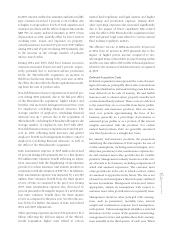American Express 2004 Annual Report Download - page 55
Download and view the complete annual report
Please find page 55 of the 2004 American Express annual report below. You can navigate through the pages in the report by either clicking on the pages listed below, or by using the keyword search tool below to find specific information within the annual report.
needs and investor demand and may change its funding
mix. The Company’s funding plan is subject to various
risks and uncertainties, such as disruption of financial
markets, market capacity and demand for securities
offered by the Company, accounting or regulatory
changes, ability to sell receivables and the performance
of receivables previously sold in securitization transac-
tions. Many of these risks and uncertainties are beyond
the Company’s control.
As of December 31, 2004, Credco had the ability to issue
approximately $7.3 billion of debt securities under shelf
registration statements filed with the SEC.
Cost of Funds
Cost of funds is generally determined by a margin or
credit spread over a benchmark interest rate. Credit
spreads are measured in basis points where 1 basis
point equals one one-hundredth of one percentage
point. Commercial paper and other short-term debt
funding costs are based on spreads benchmarked
against London Interbank Offered Rate (LIBOR), a com-
monly used interest rate. Costs for unsecured long-term
debt and securitized funding are based on spreads
benchmarked against LIBOR, U.S. Treasury securities of
similar maturities or other rates.
Asset Securitizations
TRS, through its subsidiaries, periodically securitizes
cardmember receivables and loans arising from its card
business. The securitization market provides TRS with
very cost-effective funding for its long-term funding
needs. Securitization of cardmember receivables and
loans is accomplished through the transfer of those assets
to a special purpose entity created for the securitization,
generally a trust, which in turn issues securities to third-
party investors that are collateralized by the transferred
assets. The issued securities represent undivided inter-
ests in the transferred assets. The proceeds from issuance
are distributed to TRS, through its wholly-owned subsid-
iaries, as consideration for the transferred assets. Securi-
tization transactions are accounted for as either a sale or
secured borrowing, based upon the structure of the
transaction.
Securitization of cardmember receivables generated
under designated consumer charge accounts are accom-
plished through the transfer of cardmember receivables
to the American Express Master Trust (the Charge Trust).
Securitizations of these receivables are accounted for as
secured borrowings because the Charge Trust is not a
qualifying special purpose entity (QSPE). Accordingly,
the related assets being securitized are not treated as sold
and the securities issued to third-party investors are
reported as long-term debt on the Company’s Consoli-
dated Balance Sheets. There were no issuances of secu-
rities from the Charge Trust during 2004 and 2003. During
2004 and 2003, $1.1 billion and $2.0 billion, respectively,
of previously issued trust securities matured.
Securitization of cardmember loans arising from various
portfolios of consumer accounts are accomplished
through the transfer of cardmember loans to a QSPE, the
American Express Credit Account Master Trust (the
Lending Trust). Securitizations of loans transferred to
the Lending Trust are accounted for as sales. Accord-
ingly, the Company removes the loans from its Consoli-
dated Balance Sheets and recognizes both a gain on sale
and other retained interests in the securitization as dis-
cussed below. As of December 31, 2004 and 2003, the
Lending Trust held total assets of $24.7 billion and $26.8
billion, respectively, of which $20.3 billion and $19.4
billion, respectively, had been sold.
TRS’ continued involvement with the securitized card-
member loans includes the process of managing and
servicing the securitized loans. In addition, TRS,
through its subsidiaries, maintains an undivided, pro-
rata interest in all loans transferred (or sold), which is
referred to as seller’s interest, and is generally equal to
the balance of the loans in the Lending Trust less the
investors’ portion of those assets. As the amount of the
loans in the Lending Trust fluctuates due to customer
payments, new charges and credit losses, the carrying
amount of the seller’s interest will vary. However, the
seller’s interest is required to be maintained at a mini-
mum level of 7% of outstanding principal in the Lending
Trust. As of December 31, 2004, the amount of seller’s
interest was approximately 18% of outstanding
principal, well above the minimum requirement.
Additionally, the Company also retains subordinated
interests in the securitized loans. Such interests include
one or more investments in tranches of the securitiza-
tion and an interest-only strip. The investments in the
tranches of the securitization are accounted for at fair
value as Available-for-Sale investment securities in
accordance with SFAS No. 115, “Accounting for Certain
Investments in Debt and Equity Securities,” and are
reported in investments on the Company’s Consoli-
dated Balance Sheets. As of December 31, 2004 and
2003, the ending fair value of these retained interests
was $0.1 billion and $1.8 billion, respectively. The
interest-only strip is also accounted for at fair value con-
sistent with a SFAS No. 115 Available-for-Sale invest-
ment but is reported in other assets on the Company’s
AXP
AR.04
53
Financial Review
























